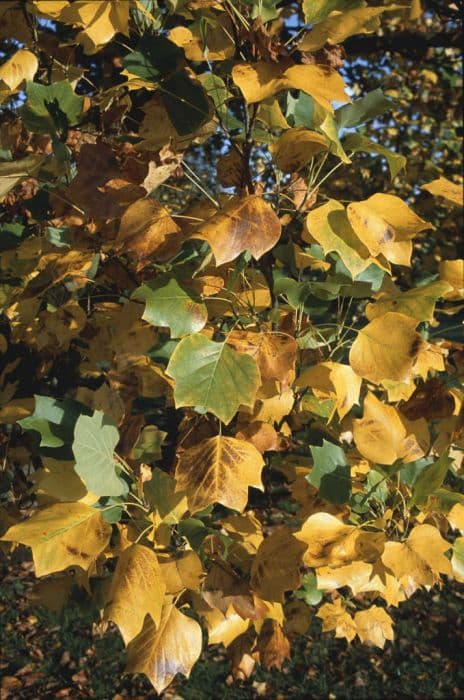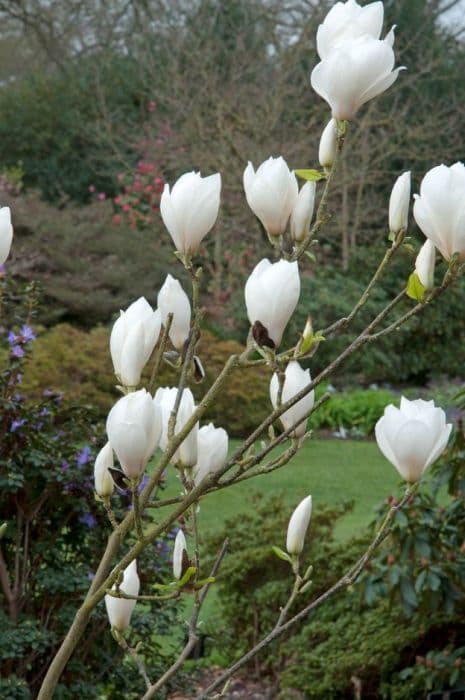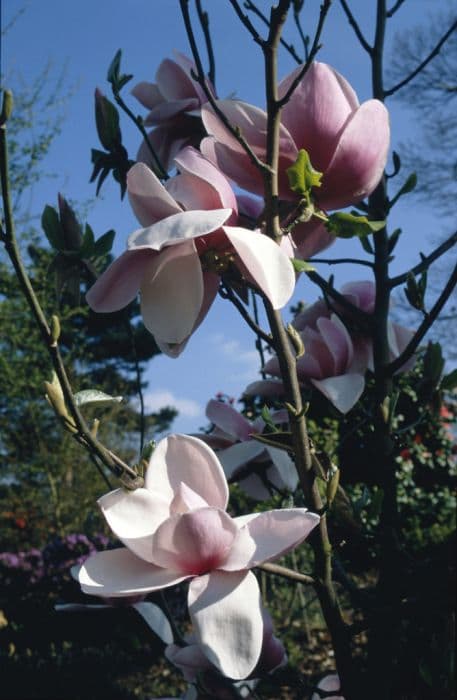Little Gem Magnolia Magnolia 'Petit Chicon'

ABOUT
The Magnolia 'Petit Chicon' is a striking plant with a lush and appealing presence. It is characterized by its large, glossy green leaves that provide a beautiful backdrop for its flowers. The flowers are particularly noteworthy, as they are the standout feature of this plant. They have a distinctive shape that is large, cup-like, and often described as tulip-shaped. The blooms are a creamy-white to pale pink color, with a subtle and pleasing fragrance that can be noticed, especially on warm days. The petals of the flowers are smooth and contribute an elegant appearance to the overall look of the plant. This magnolia variety blooms in the spring, bringing a burst of beauty to the landscape after the dormancy of winter. The bark of the Magnolia 'Petit Chicon' is typically a medium brown, with a smooth to slightly rough texture, providing a nice contrast to its flowers and foliage. Overall, this plant exudes a sense of calmness and serenity, making it a popular choice for garden enthusiasts looking for an ornamental addition to their spaces.
About this plant
 Names
NamesFamily
Magnoliaceae
Synonyms
There are no specific common names for the Magnolia 'Petit Chicon', it is often referred to by its cultivar name.
Common names
Magnolia 'Petit Chicon'
 Toxicity
ToxicityTo humans
Magnolia (the most common name for Magnolia 'Petit Chicon') is not typically considered toxic to humans. There is no well-documented evidence that suggests the magnolia plant, including its flowers, leaves, or bark, is poisonous to people if ingested. Therefore, there are no specific symptoms of poisoning associated with magnolias for humans.
To pets
Magnolia, in general, is not considered highly toxic to pets. The Magnolia 'Petit Chicon', much like other magnolias, isn't commonly associated with severe toxicity in animals. If a pet ingests parts of a magnolia, they might experience mild gastrointestinal upset, but serious symptoms or severe poisoning is not typically reported. It is always wise, however, for pet owners to monitor their pets and consult with a veterinarian if any unusual signs are observed after ingestion of plant material.
 Characteristics
CharacteristicsLife cycle
Perennials
Foliage type
Deciduous
Color of leaves
Green
Flower color
White
Height
10 feet (3 meters)
Spread
6 feet (1.8 meters)
Plant type
Tree
Hardiness zones
5
Native area
Southeast Asia
Benefits
 General Benefits
General Benefits- Ornamental value: Adds aesthetic appeal to gardens with its attractive flowers and foliage.
- Wildlife attraction: Can attract pollinators such as bees and butterflies, contributing to the biodiversity of the area.
- Shade provider: When mature, it can offer shade in gardens and urban environments.
- Seasonal interest: Offers year-round interest with its evergreen leaves and seasonal blooms.
- Low maintenance: Generally requires minimal care once established, making it suitable for various landscapes.
- Durability: Often resilient to pests and diseases, which can reduce the need for chemical treatments.
 Medical Properties
Medical PropertiesThis plant is not used for medical purposes.
 Air-purifying Qualities
Air-purifying QualitiesThis plant is not specifically known for air purifying qualities.
 Other Uses
Other Uses- Floral Arrangements: Magnolia flowers can be used in fresh floral arrangements, adding elegance and a strong fragrance to bouquets and centerpieces.
- Culinary Garnish: The blossoms of some Magnolia varieties are edible and can be used to add a decorative touch to salads and desserts.
- Crafting Material: Magnolia seed pods and dried leaves can be used in making crafts such as wreaths, ornaments, and other decorative items.
- Essential Oils: Magnolia flowers can be processed to create essential oils that are used for perfumes and aromatherapy.
- Fabric Dyeing: The bark of the Magnolia tree can be boiled and used as a natural dye for fabrics, though this is not common for 'Petit Chicon' specifically.
- Photography Subject: 'Petit Chicon' with its compact growth habit is an attractive subject for garden and plant photographers.
- Nature-Inspired Art: Magnolia's unique flowers and structure can serve as inspiration or subjects for painters and illustrators.
- Soil Enrichment: Fallen Magnolia leaves decompose and can help enrich and acidify the soil, benefiting acid-loving plants when used as mulch.
- Cultural Symbolism: Magnolia trees are often planted to symbolize dignity and nobility, adding meaning to the landscape.
- Woodworking: Wood from Magnolia trees is sometimes used in furniture making and interior woodworking projects due to its beauty and workability.
Interesting Facts
 Feng Shui
Feng ShuiThe Magnolia is traditionally associated with purity and nobility in Feng Shui. It's used to attract positive energy and can be placed in the front yard to invite wealth or in the backyard for peace and tranquility. Its white flowers symbolize purity, making it an auspicious plant for enhancing one's personal growth and spiritual understanding.
 Zodiac Sign Compitability
Zodiac Sign CompitabilityThe Magnolia is not used in astrology practice.
 Plant Symbolism
Plant Symbolism- Nobility: In ancient China, magnolias were thought to be the perfect symbols of nobility and dignity.
- Purity: The magnolia’s white flowers are commonly associated with purity and innocence.
- Perseverance: Magnolias can withstand harsh conditions, making them a symbol of perseverance and endurance.
- Femininity: Their soft, fragrant blossoms have made magnolias a representation of grace, beauty, and femininity.
- Peace: Magnolias often represent tranquility and are used to convey a sense of peacefulness.
 Water
WaterThe Little Gem Southern Magnolia should be watered deeply to keep the soil consistently moist but not waterlogged, especially during its first few years to establish a strong root system. Typically, watering once a week with about 1.5 to 2 gallons of water is sufficient, but this may vary with climate and soil conditions. During hotter, dry periods, increase the frequency to twice a week. In the winter, you can reduce watering as the plant goes dormant and requires less moisture. Always check the soil moisture level before watering to avoid overwatering.
 Light
LightLittle Gem Southern Magnolias thrive in full sun to partial shade conditions. A location that receives at least 4 to 6 hours of direct sunlight daily is optimal. They can tolerate some shade, but too much can lead to fewer flowers and a less dense foliage. Ensure the spot is away from taller trees or buildings that might cast too much shade on the plant.
 Temperature
TemperatureLittle Gem Southern Magnolias are hardy in temperatures ranging from 10°F to 100°F, but they grow best in conditions that remain between 70°F and 90°F. They can survive brief dips below this range but should be protected from prolonged exposure to extreme cold. Ensuring good air circulation can help the magnolia cope with higher temperatures.
 Pruning
PruningPruning the Little Gem Southern Magnolia is generally done to shape the plant, remove dead or crossed branches, and promote healthy growth. The best time for pruning is after the flowering season, in late summer or early fall, to minimize disruption to the blooming cycle. Aim to prune sparingly, as magnolias do not respond well to heavy cutting.
 Cleaning
CleaningAs needed
 Soil
SoilThe best soil mix for the Southern Magnolia should be rich, acidic (pH 5.0-6.5), and well-draining. A blend containing compost, pine bark, and coarse sand or perlite is ideal to ensure proper moisture retention and aeration.
 Repotting
RepottingSouthern Magnolias generally do not need frequent repotting; repotting every 3-5 years is sufficient, depending on the growth rate and pot size.
 Humidity & Misting
Humidity & MistingSouthern Magnolias prefer moderate humidity levels but are adaptable to a range of conditions. They do not require special humidity considerations when grown outdoors.
 Suitable locations
Suitable locationsIndoor
Place in bright, indirect light; water when topsoil feels dry.
Outdoor
Plant in full sun to partial shade with moist, well-drained soil.
Hardiness zone
7-10 USDA
 Life cycle
Life cycleThe Magnolia 'Petit Chicon', commonly known as Dwarf Magnolia, begins its life cycle with seed germination, which occurs when the environmental conditions are favorable, typically in spring. Following germination, the seedling grows into a small shrub, undergoing a period of vegetative growth where it develops roots, stems, and leaves. As the plant matures, it enters the flowering stage, typically in early spring to late spring, producing its characteristic fragrant, white or cream flowers. After pollination, often facilitated by beetles which are attracted to the flowers' scent, the Dwarf Magnolia then produces cone-like fruit that contains the seeds. The seeds are dispersed by wind, gravity, or sometimes by animals, allowing for the potential establishment of new plants. Over time, the plant may experience periods of dormancy during colder months, allowing it to conserve energy before the cycle begins anew with the next growing season.
 Propogation
PropogationPropogation time
Spring-Early Summer
Propogation: The most popular method of propagation for the Magnolia 'Petit Chicon', commonly known simply as Magnolia, is by semi-hardwood cuttings taken in summer. This involves selecting a healthy, non-flowering branch from the current season's growth and cutting a piece about 4 to 6 inches (approximately 10 to 15 centimeters) in length. The cutting should have several leaves but the lower 1 to 2 inches (2.5 to 5 centimeters) of leafy material must be removed. The base of the cutting is then dipped in a rooting hormone to encourage root growth and planted in a well-draining potting mix. The cutting should be kept under high humidity, either by covering it with a plastic bag or placing it in a propagator, and kept out of direct sunlight until roots have developed, which can take several weeks to a few months depending on conditions.









